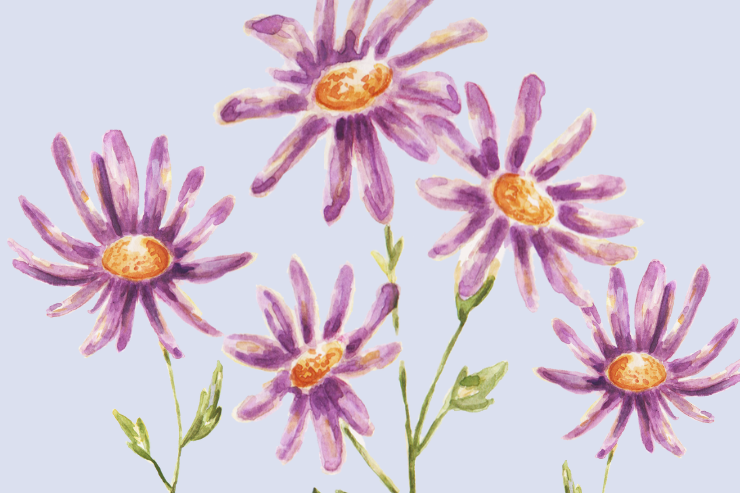
The star of my Autumn garden is undoubtedly the New England Aster. This native wildflower has become my secret weapon in keeping the butterfly party going long after other plants have hung up their petals for the season.
Now, I’ll admit, when I first stumbled upon the New England Aster at my local nursery, I was skeptical. Its scraggly appearance in those little plastic pots didn’t exactly scream “garden superstar.” But oh, how wrong I was to judge this book by its cover!
Fast forward a few years, and these magnificent plants have become the cornerstone of my late-season butterfly garden. Their vibrant purple blooms, reminiscent of a twilight sky, burst open just when the garden needs it most, typically from August through October. It’s as if Mother Nature decided to throw one last bash before Winter crashes the party.
But let’s talk about why the New England Aster is such a hit with our fluttering friends. You see, this plant isn’t just a pretty face—it’s a vital food source for butterflies preparing for migration or hibernation. The nectar-rich flowers are like energy drinks for butterflies, providing that crucial last boost before the cold sets in.
How to Grow New England Aster
I’ll never forget the day I saw my first Monarch butterfly land on a New England Aster. It was late September, and I thought the butterfly season was over. But there it was, its orange wings a stark contrast against the purple flowers, sipping nectar like it was the finest wine. Since then, I’ve seen countless species visit these blooms—Painted Ladies, Red Admirals, Clouded Sulphurs, and even the occasional late-season swallowtail.
Now, let me share a few fun facts about this unsung hero of the butterfly garden:
- Despite its name, the New England Aster isn’t just found in New England. It’s native to much of eastern and central North America.
- In the wild, New England Asters can grow up to 6 feet tall! In the garden, they’re usually a more manageable 3-4 feet.
- Native Americans used New England Aster medicinally to treat fevers and diarrhea … fun!
- The Latin name, Symphyotrichum novae-angliae, is quite a mouthful. “Novae-angliae” simply means “of New England.”
So, you’re sold on the New England Aster and want to add it to your garden? Fantastic! Here are my top tips for growing these beauties:
- Sun is key: New England Asters love full sun. They’ll tolerate partial shade, but for the best blooms and sturdiest plants, give them at least 6 hours of direct sunlight daily.
- Soil matters: These plants prefer moist, well-drained soil. In my experience, they’re not too picky, but they don’t like wet feet. If your soil is heavy clay, consider amending it with some compost.
- Water wisely: While establishing, keep your New England Asters consistently moist. Once they’re settled in, they’re fairly drought-tolerant, but appreciate extra water during dry spells.
- Pinch for bushiness: Here’s a pro tip—pinch back the growing tips in late spring to early summer. This encourages branching and results in a fuller, more floriferous plant.
- Support if needed: In rich soil or partial shade, New England Asters can get a bit floppy. Don’t be afraid to stake them or use grow-through supports.
- Divide and conquer: Every 3-4 years, divide your New England Asters in Spring. This keeps them vigorous and gives you free plants to spread around the garden or share with friends.
- Embrace the mess: In Winter, leave the dried stalks standing. They provide shelter for beneficial insects and food for birds.
I remember the first time I followed these tips with my New England Asters. I was skeptical about the pinching back—it felt counterintuitive to snip off perfectly good growth. But come fall, those plants were bushier and more bloom-laden than ever before. It was like they were thanking me for the tough love.
Now, every Autumn, as I watch clouds of butterflies and bees working over my New England Asters, I’m reminded of why I garden. It’s not just about pretty flowers or a perfect lawn. It’s about creating a space that nurtures life, that plays a small but vital role in the grand tapestry of nature.
So, are you ready to join the New England Aster fan club? Trust me, once you’ve experienced the joy of a garden buzzing with late-season pollinators, you’ll wonder how you ever lived without these amazing plants.
And if you want to learn more about planting a butterfly garden, download our Butterfly Gardening in America GuideBook. It includes charts that are divided into sections, so you know which plants or flowers you can grow based on the type of soil and amount of sun your garden gets. We also cover history, popular varietals, plant hardiness zones, and basic care instructions for nurturing natures winged wonders. Download now!
I’m curious to hear from you all. What’s your go-to plant for attracting late-season butterflies? Have you had any experience with New England Asters, good or bad? And for those of you who already grow them, what’s been your most memorable butterfly visitor? Share your stories in the comments below—after all, the best part of gardening is sharing our triumphs (and occasional failures) with fellow plant enthusiasts!



